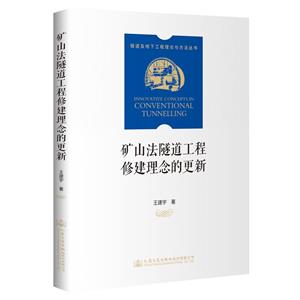扫一扫
关注中图网
官方微博
本类五星书更多>
-
>
湖南省志(1978-2002)?铁路志
-
>
公路车宝典(ZINN的公路车维修与保养秘籍)
-
>
晶体管电路设计(下)
-
>
基于个性化设计策略的智能交通系统关键技术
-
>
德国克虏伯与晚清火:贸易与仿制模式下的技术转移
-
>
花样百出:贵州少数民族图案填色
-
>
识木:全球220种木材图鉴
矿山法隧道工程修建理念的更新 版权信息
- ISBN:9787114171925
- 条形码:9787114171925 ; 978-7-114-17192-5
- 装帧:一般胶版纸
- 册数:暂无
- 重量:暂无
- 所属分类:>>
矿山法隧道工程修建理念的更新 内容简介
本书基于作者在矿山法隧道工程修建中积累的经验和教训,以围岩稳定性和力学行为的控制、隧道结构设计模型、挤压性围岩大量级变形、地下水处治、衬砌结构形式的拓展等为主要内容,对矿山法隧道工程修建理念及其技术背景进行了论述,并就若干认识上的“模糊点”进行探讨。??本书可供隧道工程设计人员、施工人员、管理者以及相关专业研究生参考。
矿山法隧道工程修建理念的更新 目录
第1讲 从“支撑”到“支护”——围岩的力学行为和工程应对理念 1
1.1 隧道结构设计模型 1
1.2 对“作用和反力”模型的质疑 2
1.3 围岩对隧道开挖的响应 6
1.4 “连续体”模型 18
1.5 “收敛—约束”模型 22
1.6 隧道设计手段的综合 24
第2讲 隧道修建理念更新的技术背景——围岩支护技术的进步 35
2.1 纤维喷射混凝土 36
2.2 岩土锚固技术 45
2.3 超前支护技术 62
第3讲 对形变压力的认识——围岩挤压型变形问题探讨 73
3.1 各类不同性质的“大变形” 73
3.2 高地应力软弱围岩的特异性 77
3.3 挤压性围岩处治理念——围岩变形的适度释放 86
3.4 可让型支护系统 88
3.5 挤压性围岩隧道工程中的岩体锚固技术 93
3.6 可让型支护案例 95
3.7 预留变形量问题 96
3.8 二次衬砌的施作时机 101
3.9 挤压型变形处治的基本理念和要点 104
第4讲 “以排为主”还是“以堵为主”——隧道工程地下水处治 107
4.1 地下水处治的主要手段、治水理念的技术背景 108
4.2 从“以排为主”到“以堵为主” 110
4.3 静水压力分布规律和全封闭方案 112
4.4 地下水排导方案 117
4.5 排导方案衬砌水压力荷载 121
4.6 水压力荷载问题的解析 124
4.7 地下水排放流量的控制 130
4.8 “限量排放”理念的内涵 134
4.9 渗流计算的数值方法 137
4.10 “双重型衬砌”的水力特性 143
4.11 关于初始水头问题 156
4.12 隧道工程地下水处治的基本理念和要点 158
第5讲 与时俱进的多样性——隧道衬砌结构形式的拓展 161
5.1 隧道衬砌结构的演变 161
5.2 挂板防水和“双重型衬砌”(DSL) 164
5.3 喷膜防水和“复合型衬砌”(CSL) 170
5.4 “单一型衬砌”(SSL) 177
5.5 衬砌结构形式的多样化 183
附录 术语的更新 187
参考文献 189
Chapter 1 From passively supporting to actively controlling
——Mechanical behavior of the surrounding rock and response concepts in tunnelling 1
1.1 Structural design models for tunnelling 1
1.2 Calling in question on “action and reaction models” 2
1.3 Response of the surrounding rock to the excavation 6
1.4 Continuum models 18
1.5 Convergence-confinement models 22
1.6 Comprehensive use of various design methods for tunnelling 24
Chapter 2 The technological background of innovative concepts in tunnelling
——Development of rock supporting techniques 35
2.1 Fiber reinforced sprayed concrete 36
2.2 Rock anchoring techniques and rock bolts 45
2.3 The advance support system 62
Chapter 3 Facing the genuine pressure
——Discussion on problems of tunnelling under squeezing ground conditions 73
3.1 Different types of so called “large deformation” 73
3.2 Specificity of the weak surrounding rock under the high in-situ pressure 77
3.3 The key way is to release deformations suitably for tunnelling
under squeezing ground conditions86
3.4 The yielding support system 88
3.5 Rock bolting for tunnelling under squeezing ground conditions 93
3.6 A project case of the yielding support system 95
3.7 The deformation allowance value for tunnelling
under squeezing ground conditions 96
3.8 The opportune moment for secondary lining construction 101
From passively supporting to actively controlling
——Mechanical behavior of the surrounding rock and response concepts in tunnelling 1
1.1 Structural design models for tunnelling 1
1.2 Calling in question on “action and reaction models” 2
1.3 Response of the surrounding rock to the excavation 6
1.4 Continuum models 18
1.5 Convergence-confinement models 22
1.6 Comprehensive use of various design methods for tunnelling 24
The technological background of innovative concepts in tunnelling
——Development of rock supporting techniques 35
2.1 Fiber reinforced sprayed concrete 36
2.2 Rock anchoring techniques and rock bolts 45
2.3 The advance support system 62
Facing the genuine pressure
——Discussion on problems of tunnelling under squeezing ground conditions 73
3.1 Different types of so called “large deformation” 73
3.2 Specificity of the weak surrounding rock under the high in-situ pressure 77
3.3 The key way is to release deformations suitably for tunnelling
under squeezing ground conditions86
3.4 The yielding support system 88
3.5 Rock bolting for tunnelling under squeezing ground conditions 93
3.6 A project case of the yielding support system 95
3.7 The deformation allowance value for tunnelling
under squeezing ground conditions 96
3.8 The opportune moment for secondary lining construction 101
3.9 Key points for tunnelling under squeezing ground conditions 104
Chapter 4 “Draining first” or “sealing first”
——Tunnel Waterproofing 107
4.1 The technical background of tunnel waterproofing concepts 108
4.2 Compare draining with sealing 110
4.3 Distribution of the static pressure caused by ground water and
discussion on the full sealing approach 112
4.4 Ground water draining approach 117
4.5 The water pressure loaded on the lining in case of application of the draining
approach 121
4.6 Analytic solution of the load caused by ground water 124
4.7 Control of the flow rate 130
4.8 Concept about the limited flow rate 134
4.9 Numerical methods for seepage calculation 137
4.10 The double shell lining under the load caused by ground water 143
4.11 Determination of the In-situ water head 156
4.12 Basic concepts and key points for tunnel waterproofing 158
Chapter 5 Multiformity of tunnel linings
——Expansion forms of tunnel lining systems 161
5.1 Development of tunnel lining forms 161
5.2 Sheet membranes and the double shell lining (DSL) 164
5.3 Spray applied membranes and the composite shell lining (CSL) 170
5.4 The single shell lining (SSL) 177
5.5 Various forms of tunnel lining systems 183
Appendix Updating of terms 187
References 189
展开全部
矿山法隧道工程修建理念的更新 作者简介
王建宇,中铁西南科学研究院(原铁道科学研究院西南分院)研究员。1940年出生,1963年毕业于唐山铁道学院桥梁与隧道系,长期从事隧道及地下工程技术开发和科研工作。 1993年经国务院学位委员会批准为博士生导师,1995年获人事部“中青年有突出贡献专家”证书,是国家科学技术进步奖特等奖项目“大瑶山长大铁路隧道修建新技术”获奖人之一,1992年获茅以升铁道科学技术奖。曾任中国土木工程学会隧道及地下工程分会副理事长,中国岩土锚固协会副理事长,《现代隧道技术》主编。 业务专长:围岩稳定性分析和支护技术。
书友推荐
- >
朝闻道
朝闻道
¥15.0¥23.8 - >
二体千字文
二体千字文
¥14.0¥40.0 - >
莉莉和章鱼
莉莉和章鱼
¥14.3¥42.0 - >
龙榆生:词曲概论/大家小书
龙榆生:词曲概论/大家小书
¥9.2¥24.0 - >
随园食单
随园食单
¥15.4¥48.0 - >
诗经-先民的歌唱
诗经-先民的歌唱
¥13.5¥39.8 - >
自卑与超越
自卑与超越
¥16.7¥39.8 - >
新文学天穹两巨星--鲁迅与胡适/红烛学术丛书(红烛学术丛书)
新文学天穹两巨星--鲁迅与胡适/红烛学术丛书(红烛学术丛书)
¥9.9¥23.0
本类畅销
-
中国传统民俗文化:建筑系列:中国古代桥梁
¥19.6¥58 -
渡河工程
¥20.2¥60 -
图说摩托车维修
¥60¥82 -
北京高速公路建设实录
¥122.4¥360 -
路文化
¥22.1¥66 -
河北高速公路建设实录
¥163.2¥480



















